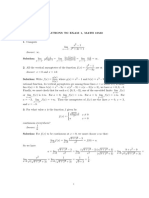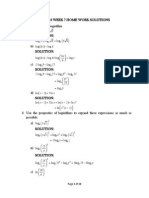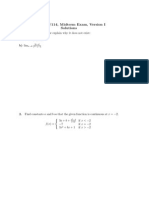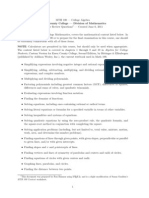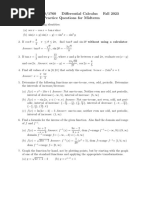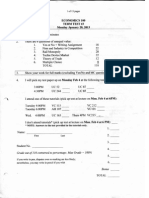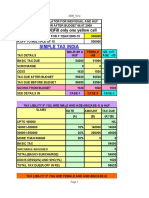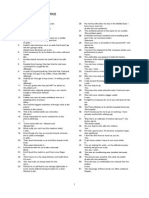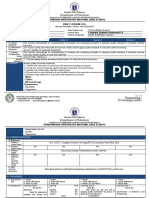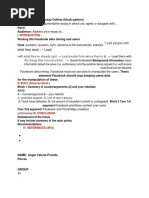Mata30 TT1 2012F
Mata30 TT1 2012F
Uploaded by
examkillerCopyright:
Available Formats
Mata30 TT1 2012F
Mata30 TT1 2012F
Uploaded by
examkillerOriginal Title
Copyright
Available Formats
Share this document
Did you find this document useful?
Is this content inappropriate?
Copyright:
Available Formats
Mata30 TT1 2012F
Mata30 TT1 2012F
Uploaded by
examkillerCopyright:
Available Formats
University of Toronto Scarborough
Department of Computer & Mathematical Sciences
MATA30: Calculus I - Midterm Test
Examiners: Sophie Chrysostomou Date: Wednesday, October 31, 2012
Duration: 110 minutes
DO NOT OPEN THIS BOOKLET UNTIL INSTRUCTED TO DO SO.
FAMILY NAME:
GIVEN NAMES:
STUDENT NUMBER:
DAY AND TIME OF YOUR TUTORIAL:
SIGNATURE:
CIRCLE THE NAME OF YOUR TEACHING ASSISTANT:
Fazle Chowdhury Fangzhou Guo Hnidec Samantha
Manaal Hussain Mike Milijanovic Ushya Shanmugarajah
Aaron Situ Shobigah Sivaloganathan Hoi Suen (John) Wong
Junsheng Wu
NOTES:
No calculators, or any electronic aid is permitted at the test room.
No cell phones are permitted.
No books, notebooks or scrap paper are permitted near your examination table.
There are 12 numbered pages in the test. It is your responsibility to ensure that, at
the start of the test, this booklet has all its pages. The last two pages (11 and 12) are
empty.
Please leave all the pages of this booklet stapled. Do not remove any pages.
Answer all questions in the space provided. Show your work and justify your answers
for full credit.
FOR MARKERS ONLY
1 / 10
2 /10
3 a / 5
3 b / 5
3 c / 5
3 d / 5
3 e / 5
4 / 5
5 / 5
6 / 10
7a / 5
7b / 5
8a / 5
8b / 5
8c / 5
8d / 5
8e / 5
TOTAL /100
MATA30F page 1
1. [ 10 mark] Let f(x) =
3
x 3
(a) [ 2 marks] Find the domain and range of f.
Solution:
The domain of f is R.
The range of f is R.
(b) [ 1 mark] Show that f is invertible.
Solution:
If x
1
= x
2
, then x
1
3 = x
2
3 and therefore
3
x
1
3 =
3
x
2
3. This shows
that f is one to one and therefore invertible.
Or: by using the horizontal line test on the graph of f below, we see that no
horizontal line crosses the graph of f more than once, so f is one to one and
therefore invertible.
-5 -4 -3 -2 -1 0 1 2 3 4 5
-5
-4
-3
-2
-1
1
2
3
4
5
(c) [ 3 marks] Find f
1
, the inverse of f, and give its domain and range.
Solution:
Let y =
3
x 3. Then:
y
3
= x 3
y
3
+ 3 = x
Switching x and y we get that the inverse function y = f
1
is given by y = x
3
+3.
The domain of f
1
is the range of f which is R.
The range of f
1
is the doman of f which is R.
(d) [ 4 marks] Give the graphs of f and f
1
.
-5 -4 -3 -2 -1 0 1 2 3 4 5
-5
-4
-3
-2
-1
1
2
3
4
5
MATA30F page 2
2. (a) [ 4 marks] If sec =
9x
3
for
3
2
, 2
and for some x > 0, nd the follow-
ing trigonometric ratios:
sin x =
81x
2
9
9x
cot x =
3
81x
2
9
Since
3
2
, 2
the angle is in the fourth quadrant. Since sec =
9x
3
, then
we could have the adjacent side have length 3 and the hypotenuse have length 9x.
Thus we get the diagram below:
0
3
9x
(b) [ 4 marks] Prove the identity:
1
1 cos x
+
1
1 + sin x
= csc
2
xsec
2
x + csc xcot x sec xtan x
Solution:
RHS =
1
1 cos x
+
1
1 + sin x
=
1 + cos x
(1 cos x)(1 + cos x
+
1 sin x
(1 + sin)(1 sin x)
=
1 + cos x
1 cos
2
x
+
1 sin x
1 sin
2
x
=
1 + cos x
sin
2
x
+
1 sin x
cos
2
x
=
cos
2
x + cos
3
x + sin
2
x sin
3
x
sin
2
xcos
2
x
=
1 + cos
3
x sin
3
x
sin
2
xcos
2
x
=
1
sin
2
xcos
2
x
+
cos
3
x
sin
2
xcos
2
x
sin
3
x
sin
2
xcos
2
x
= csc
2
xsec
2
x +
cos x
sin
2
x
sin x
cos
2
x
= csc
2
xsec
2
x + csc xcot x sec xtanx = LHS
Thus:
1
1 cos x
+
1
1 + sin x
= csc
2
xsec
2
x + csc xcot x sec xtan x
(c) [ 2 marks] Find all x R satisfying: log
x
(12 2x x
2
) = 2.
Solution: Since x is a base of a logarithmic function, then x > 0 and by the
denition of the logarithmic function:
log
x
(12 2x x
2
) = 2 x
2
= 12 2x x
2
We need to nd the solution to x
2
= 12 2x x
2
or 2x
2
+ 2x 12 = 0
0 = 2x
2
+ 2x 12 = 2(x
2
+ x 6) = 2(x 2)(x + 3)
The roots of the quadratic are x = 2 or x = 3 however, since x must be positive
then the only solution is x = 2.
MATA30F page 3
3. [25 marks total] Evaluate each of the following limits, else explain why the limit does
not exist. Justify your answer. Do not use LH ospitals rule.
(a) lim
x5
x
2
3x 10
x
2
25
Solution:
lim
x5
x
2
3x 10
x
2
25
= lim
x5
(x 5)(x + 2)
(x 5)(x + 5)
= lim
x5
(x + 2)
(x + 5)
=
7
10
(b) lim
x0
x
1 + x
1 x
Solution:
lim
x0
x
1 + x
1 x
= lim
x0
x
(
1 + x
1 x)
1 + x +
1 x)
(
1 + x +
1 x)
= lim
x0
x(
1 + x +
1 x)
(1 + x (1 x))
= lim
x0
x(
1 + x +
1 x)
2x
= lim
x0
(
1 + x +
1 x)
2
=
(
1 +
1)
2
= 1
(c) lim
x4
2x +|2x|
x +|x|
.
Solution:
lim
x4
2x +|2x|
x +|x|
=
2 4 +|2 4|
4 +|4|
=
16
8
= 2
MATA30F page 4
(d) lim
x
e
x
cos(x +
1
x
)
Solution: Since for all x R,
1 cos x 1,
then for all x = 0:
1 cos(x +
1
x
) 1
e
x
e
x
cos(x +
1
x
) e
x
.
Since lim
x
e
x
= 0 and lim
x
e
x
= 0,
lim
x
e
x
cos(x +
1
x
) = 0 by the squeeze theorem.
(e) lim
x1
tan(x 1)
2x 2
Solution:
lim
x1
tan(x 1)
2x 2
= lim
x1
sin(x 1)
cos(x 1)(2x 2)
= lim
x1
sin(x 1)
(x 1)
1
2 cos(x 1)
=
1
2
MATA30F page 5
4. [5 marks] Let f(x) =
(x
2
9)(x
2
4)
(x
4
x
3
6x
2
)
. Find all the horizontal and vertical asymp-
totes of f. Justify your answer by using appropriate limits.
Solution:
For horizontal asymptotes:
lim
x
(x
2
9)(x
2
4)
(x
4
x
3
6x
2
)
= lim
x
(x
4
13x
2
+ 36)
(x
4
x
3
6x
2
)
= lim
x
x
4
x
4
13x
2
x
4
+
36
x
4
x
4
x
4
x
3
x
4
6x
2
x
4
= lim
x
1
13
x
2
+
36
x
4
1
1
x
6
x
2
= 1
lim
x
(x
2
9)(x
2
4)
(x
4
x
3
6x
2
)
= lim
x
(x
4
13x
2
+ 36)
(x
4
x
3
6x
2
)
= lim
x
x
4
x
4
13x
2
x
4
+
36
x
4
x
4
x
4
x
3
x
4
6x
2
x
4
= lim
x
1
13
x
2
+
36
x
4
1
1
x
6
x
2
= 1
Thus there is one horizontal asymptote, y = 1.
For vertical asymptotes we rst simplify by factoring the function as much as possible:
f(x) =
(x
2
9)(x
2
4)
(x
4
x
3
6x
2
)
=
(x 3)(x + 3)(x 2)(x + 2)
x
2
(x
2
x 6)
=
(x 3)(x + 3)(x 2)(x + 2)
x
2
(x 3)(x + 2)
So
f(x) =
(x + 3)(x 2)
x
2
for all x R, x / {2, 0, 3}
Thus:
lim
x2
(x + 3)(x 2)
x
2
=
4
4
= 1
lim
x3
(x + 3)(x 2)
x
2
=
6
9
=
2
3
lim
x0
f(x) = lim
x0
(x + 3)(x 2)
x
2
=
(as x 0 (x + 3)(x 2) 3(2) = 6 < 0 the denominator x
2
0
+
.)
This shows that f has one vertical asymptote at x = 0.
MATA30F page 6
5. [5 marks] Given some numbers a and b, dene f : R R by
f(x) =
sin(17x)
sin(x)
if x < 0 ,
ax + b if 0 x 1 ,
ln(x) if x > 1 ,
Find a and b so that f is continuous on (/2, ). Fully justify your answers.
Solution:
Since sin 17x, sin x are both continuous for all x R and sin x = 0 for x = k for
k Z. Then
sin(17x)
sin(x)
is continuous on
2
, 0
.
Since ax + b is a polynomial then it is continuous on (0, 1).
Also, ln x is continuous on (0, ) therefore it is continuous on (1, ).
For f to be continuous at x = 0 we need
lim
x0
f(x) = lim
x0
+
f(x) = f(0).
So
lim
x0
f(x) = lim
x0
sin(17x)
sin(x)
= lim
x0
sin(17x)
17x
x
sin x
17x
x
= lim
x0
sin(17x)
17x
lim
x0
x
sin(x)
lim
x0
17)
1
= 1 1 17 lim
0
sin
= 1
= 17
lim
x0
+
f(x) = lim
x0
+
ax + b = b = f(0)
For continuity at 0 we need b = 17.
For continuity at 1 we need
lim
x1
f(x) = lim
x1
+
f(x) = f(1).
lim
x1
f(x) = lim
x1
ax + b = a + b = a + 17 = f(1)
lim
x1
+
f(x) = lim
x1
+
ln(x) = ln(1) = 0
For continuity at 1 we need a + 17 = 0 or a = 17.
Thus, if a = 17 and b = 17, then f is continuous on (/2, ).
MATA30F page 7
6. [10 marks] Determine if there is a solution to
x
5/3
+ x
2/3
+ 6 = 0 .
Justify your answer and give the full statement of the theorem you used.
Solution: Since the function f(x) = x
5/3
+x
2/3
+6 is the sum of powers of root functions
that are continuous on R, then f is continuous on R.
f(0) = 6 > 0 and
f(8) = (8)
5/3
+ (8)
2/3
+ 6
= (
3
8)
5
+ (
3
8)
2
+ 6
= (2)
5
+ (2)
2
+ 6
= 32 + 4 + 6 = 22 < 0
We have that f(8) < 0 < f(0) and since f is continuous on [8, 0], then by the
Intermediate Value Theorem there is some c (8, 0) such that f(c) = 0.
Thus there is at least one solution to x
5/3
+ x
2/3
+ 6 = 0 in (8, 0).
The Intermediate Value Theorem: If f is continuous on [a, b] and w is between f(a)
and f(b), then there is some c (a, b) such that f(c) = w.
MATA30F page 8
7. (a) [5 marks] Let f(x) =
1
x 2
. Use the denition of the derivative to nd f
(x).
Solution:
lim
h0
f(x + h) f(x)
h
= lim
h0
1
x+h2
1
x2
h
= lim
h0
1
x+h2
1
x2
h
= lim
h0
(x2)(x+h2)
(x2)(x+h2)
h
= lim
h0
h
(x 2)(x + h 2)h
= lim
h0
1
(x 2)(x + h 2)
=
1
(x 2)
2
(b) [5 marks] Find the line tangent line to the graph of f(x) =
1
x 2
at the point
(4, 1/2).
Solution:
Since f(4) =
1
4 2
=
1
2
, then the point (4, 1/2) is on the graph of f.
The slope of the tangent line at (4, 1/2) is m = f
(4) =
1
(4 2)
2
=
1
4
.
Thus:
1
4
=
y
1
2
x 4
Thus, the equation of the tangent line is y =
1
2
1
4
(x 4) =
1
4
x +
3
2
.
MATA30F page 9
8. [5 marks each; 25 marks] For the following given functions use dierentiation rules
to nd their required derivatives. Do not simplify.
(a) [5 marks] f(x) = e
x
(1 + sec x). Find f
(x).
Solution: Using the product rule and the chain rule:
f
(x) = e
x
(1 + sec x) + e
x
sec xtan x
(b) [5 marks] g(x) =
arcsin(x)
1 x
2
. Find g
(x).
Solution:
g
(x) =
1
1x
2
1 x
2
arcsin x
1
2
1x
2
(2x)
(
1 x
2
)
2
=
1x
2
1x
2
+
xarcsin x
1x
2
1 x
2
=
1x
2
+xarcsin x
1x
2
1 x
2
=
1 x
2
+ xarcsin x
1 x
2
(1 x
2
)
=
1 x
2
+ xarcsin x
(1 x
2
)
3/2
(c) [5 marks] g(x) = 2 sin(ln(x)) cos(ln(x)). Find g(x).
Solution: Using the product rule and the chain rule:
g
(x) = 2 cos(ln(x))
1
x
cos(ln(x)) + 2 sin(ln(x))(sin(ln x))
1
x
.
g
(x) =
2
x
[cos
2
(ln(x)) sin
2
(ln(x))] =
2
x
cos(2 lnx).
Or using the double angle identity sin 2y = 2 sin y cos y we get that g(x) =
2 sin(ln(x)) cos(ln(x)) = sin(2 lnx), thus
g
(x) = cos(2 lnx)
2
x
.
MATA30F page 10
(d) [5 marks] h(x) = (x + 1)
tan
2
x
. Find h(x).
Solution: Logarithmic dierentiation is needed.
Let y = h(x). Then y = (x + 1)
tan
2
x
.
Taking the natural logarithm of both sides and simplifying:
ln y = (tan
2
x) ln(x + 1)
Using implicit dierentiation:
1
y
y
= 2(tanx)(sec
2
x) ln(x + 1) + tan
2
x
1
(x + 1)
Thus:
y = y
2(tanx)(sec
2
x) ln(x + 1) +
tan
2
x
(x + 1)
= (x + 1)
tan
2
x
2(tanx)(sec
2
x) ln(x + 1) +
tan
2
x
(x + 1)
(e) [5 marks] If e
xy
= e
4x
e
5y
, nd
dy
dx
.
Solution: Using implicit dierentiation on e
xy
= e
4x
e
5y
, we get:
e
xy
(y + xy
) = e
4x
4 e
5y
5y
.
Isolating all terms with y
on one side of the equation we get:
ye
xy
+ xy
e
xy
= e
4x
4 e
5y
5y
.
xy
e
xy
+ e
5y
5y
= 4e
4x
ye
xy
y
(xe
xy
+ 5e
5y
) = 4e
4x
ye
xy
Finally:
y
=
4e
4x
ye
xy
xe
xy
+ 5e
5y
MATA30F page 11
This page is intentionally blank.
MATA30F page 12
This page is intentionally blank.
You might also like
- Mgeb02 FinalDocument4 pagesMgeb02 FinalexamkillerNo ratings yet
- Cambridge Grammar IeltsDocument246 pagesCambridge Grammar Ielts1111b071No ratings yet
- MA1505 Tutorial Solution 1Document6 pagesMA1505 Tutorial Solution 1Bilguun BatboldNo ratings yet
- Calculus 1 By: Grace Carticiano & Francheska Cuison Quizzes Quiz 3Document17 pagesCalculus 1 By: Grace Carticiano & Francheska Cuison Quizzes Quiz 3Jas John50% (8)
- ECON 101 Final Practice1Document32 pagesECON 101 Final Practice1examkillerNo ratings yet
- University of Toronto Scarborough Department of Computer & Mathematical Sciences MATA30: Calculus I - Solution Midterm TestDocument12 pagesUniversity of Toronto Scarborough Department of Computer & Mathematical Sciences MATA30: Calculus I - Solution Midterm TestexamkillerNo ratings yet
- Homework #2 Solutions Problems: Math 19: Calculus Summer 2010Document6 pagesHomework #2 Solutions Problems: Math 19: Calculus Summer 2010AnaMendezNo ratings yet
- Math 113G1/114E1 Midterm Solutions (V1)Document15 pagesMath 113G1/114E1 Midterm Solutions (V1)examkillerNo ratings yet
- Solution Inform Test 01Document5 pagesSolution Inform Test 01Shawn SagarNo ratings yet
- Sample Calculus ProblemsDocument141 pagesSample Calculus ProblemsRedion XhepaNo ratings yet
- Math 53 LE 3 Reviewer ProblemsDocument14 pagesMath 53 LE 3 Reviewer ProblemsJc QuintosNo ratings yet
- SGW Limits Solns PDFDocument6 pagesSGW Limits Solns PDFDamrongNo ratings yet
- Polynomials Over Integers: Note PrintsDocument14 pagesPolynomials Over Integers: Note PrintsKomanduri Murali SrinivasNo ratings yet
- Challenging Problems01Document3 pagesChallenging Problems01ashutosh_p29No ratings yet
- Cal1_Midterm_S2_2023_24Document3 pagesCal1_Midterm_S2_2023_24vylam nguyenNo ratings yet
- HW 2 Solutions For CalculusDocument9 pagesHW 2 Solutions For CalculusNguyen PhamNo ratings yet
- Exam1f13 Solution PDFDocument6 pagesExam1f13 Solution PDFAde RahmaNo ratings yet
- Blue Print: Class Xii Maths: Model Question PaperDocument14 pagesBlue Print: Class Xii Maths: Model Question Paperapi-243565143No ratings yet
- 175 Fall2009 Final SolDocument6 pages175 Fall2009 Final Solnurullah_bulutNo ratings yet
- Advanced Algeb ProjectDocument17 pagesAdvanced Algeb ProjectdiomNo ratings yet
- Preparatory Questions: 1. Verify That The Function FDocument6 pagesPreparatory Questions: 1. Verify That The Function FTOM DAVISNo ratings yet
- MA1521 Solution3Document5 pagesMA1521 Solution3Ray TanNo ratings yet
- FX X X X Orx X X X FX X X: Test 1 SolutionsDocument4 pagesFX X X X Orx X X X FX X X: Test 1 SolutionsexamkillerNo ratings yet
- Limit of A FunctionDocument29 pagesLimit of A FunctionMariela CambaNo ratings yet
- Maths Week 4Document49 pagesMaths Week 4diyashah17008046No ratings yet
- Putnam 1998 (Problems and Solutions)Document7 pagesPutnam 1998 (Problems and Solutions)Abir MahmudNo ratings yet
- Mat112 Week 7 Home Work SolutionDocument10 pagesMat112 Week 7 Home Work SolutionolasunmboNo ratings yet
- Calculus 1.Final Exam.Solutions.Practice 2Document17 pagesCalculus 1.Final Exam.Solutions.Practice 20cb7n9d5eNo ratings yet
- Quiz 1 Problems and SolutionsDocument10 pagesQuiz 1 Problems and SolutionsNafiur RahmanNo ratings yet
- School of Mathematics and Physics, The University of QueenslandDocument1 pageSchool of Mathematics and Physics, The University of QueenslandVincent LiuNo ratings yet
- Math 113/114, Midterm Exam, Version I Solutions: X 4 4 X 5 X +9 - 3 X - X X 6Document3 pagesMath 113/114, Midterm Exam, Version I Solutions: X 4 4 X 5 X +9 - 3 X - X X 6examkillerNo ratings yet
- MTH 100 Review Key 01Document24 pagesMTH 100 Review Key 01AB876No ratings yet
- CalculateDocument88 pagesCalculatenobody knowNo ratings yet
- Math 31 Chapter 10 and 11 LessonsDocument26 pagesMath 31 Chapter 10 and 11 LessonsSam PanickerNo ratings yet
- Mathematics 113 (A1) Final Examination Fall 2010: InstructionsDocument4 pagesMathematics 113 (A1) Final Examination Fall 2010: InstructionsexamkillerNo ratings yet
- Zeashan Zaidi: Lecturer BiostatisticsDocument34 pagesZeashan Zaidi: Lecturer BiostatisticszeashanzaidiNo ratings yet
- AP Review Chapter 3Document20 pagesAP Review Chapter 3DSaulBNo ratings yet
- Calculus 1 By: Grace Carticiano Quizzes Quiz 3Document15 pagesCalculus 1 By: Grace Carticiano Quizzes Quiz 3Aifha RamosNo ratings yet
- RS Aggarwal Solution Class 10 Maths Chapter 2 Polynomials Exercise 2BDocument14 pagesRS Aggarwal Solution Class 10 Maths Chapter 2 Polynomials Exercise 2BThe Time ParadoXNo ratings yet
- 1stmid PDFDocument5 pages1stmid PDFbingoNo ratings yet
- Calculus 2Document78 pagesCalculus 2Christian Lance RegnerNo ratings yet
- Test 1 SolutionsDocument3 pagesTest 1 SolutionsexamkillerNo ratings yet
- Math 242: Exam 1 Review QuestionsDocument3 pagesMath 242: Exam 1 Review Questionssuperfr3shmNo ratings yet
- S2 NRSm3 PDFDocument26 pagesS2 NRSm3 PDFbomtozorNo ratings yet
- HW 1 Solutions For Calculus IDocument7 pagesHW 1 Solutions For Calculus IHa NoiNo ratings yet
- Correct Answer Is B) Lim F (X)Document8 pagesCorrect Answer Is B) Lim F (X)AneelaMalikNo ratings yet
- Fall 2013 PDFDocument10 pagesFall 2013 PDFlopezmegoNo ratings yet
- MA1102RSoln1 (Partial)Document3 pagesMA1102RSoln1 (Partial)Anonymous t4uG4pFdNo ratings yet
- Midterms To Finals MATH 6100Document44 pagesMidterms To Finals MATH 6100Sean Chua83% (6)
- Jan98 MA1002 CalculusDocument6 pagesJan98 MA1002 CalculusZama MakhathiniNo ratings yet
- 12 HPWT 3 KeyDocument8 pages12 HPWT 3 Keymohan rajNo ratings yet
- Limits Exercises With AnswersDocument17 pagesLimits Exercises With Answersabd_93100% (3)
- Mathematics TDocument62 pagesMathematics TRosdy Dyingdemon100% (1)
- C3 Chapter 4Document45 pagesC3 Chapter 4Lis ViegasNo ratings yet
- 1720And1760Practice Midterm F23Document3 pages1720And1760Practice Midterm F23kimayaNo ratings yet
- Maths Model Test Paper For Summative Assessment - 1Document13 pagesMaths Model Test Paper For Summative Assessment - 1Apex InstituteNo ratings yet
- Basic Differentiation FormulasDocument6 pagesBasic Differentiation FormulasRevathi AnbunesanNo ratings yet
- Math 121 Test 1 Review 1Document3 pagesMath 121 Test 1 Review 1Sapna StanleyNo ratings yet
- Trigonometric Ratios to Transformations (Trigonometry) Mathematics E-Book For Public ExamsFrom EverandTrigonometric Ratios to Transformations (Trigonometry) Mathematics E-Book For Public ExamsRating: 5 out of 5 stars5/5 (1)
- Differentiation (Calculus) Mathematics Question BankFrom EverandDifferentiation (Calculus) Mathematics Question BankRating: 4 out of 5 stars4/5 (1)
- Analytic Geometry: Graphic Solutions Using Matlab LanguageFrom EverandAnalytic Geometry: Graphic Solutions Using Matlab LanguageNo ratings yet
- Eco100y1 Wolfson Tt4 2013wDocument11 pagesEco100y1 Wolfson Tt4 2013wexamkillerNo ratings yet
- Eco100y1 Wolfson Tt2 2012fDocument12 pagesEco100y1 Wolfson Tt2 2012fexamkillerNo ratings yet
- Eco100y1 Wolfson Tt3 2013wDocument13 pagesEco100y1 Wolfson Tt3 2013wexamkillerNo ratings yet
- Land Clearing-Section 24Document8 pagesLand Clearing-Section 24pmcisissengueNo ratings yet
- CssDocument9 pagesCssSheng Suelto CarpenteroNo ratings yet
- Padlet Wa2132yg37zl2eylDocument8 pagesPadlet Wa2132yg37zl2eyllubna imranNo ratings yet
- Materials Today: Proceedings: S. Krishna Satya, P.S. Rama SreekanthDocument5 pagesMaterials Today: Proceedings: S. Krishna Satya, P.S. Rama SreekanthGuilherme Dos Santos MoreiraNo ratings yet
- LESSON PLAN (G7 English)Document12 pagesLESSON PLAN (G7 English)madznaNo ratings yet
- 6 Habits of Highly Successful People Before BedtimeDocument4 pages6 Habits of Highly Successful People Before BedtimethavaNo ratings yet
- DwiDocument17 pagesDwiPandu PrasetyoNo ratings yet
- Principles of ArtDocument8 pagesPrinciples of Artchristianlloydconcepcion1120No ratings yet
- ConsignmentDocument2 pagesConsignmentEmma Mariz Garcia100% (1)
- Tax Calculator AY 09-10Document4 pagesTax Calculator AY 09-10madhuamsNo ratings yet
- Types of Quadrilateral: Angles in QuadrilateralsDocument5 pagesTypes of Quadrilateral: Angles in QuadrilateralsJohn Philip ReyesNo ratings yet
- Rephrasing Practice: (His) Having / The Fact That He Had BeenDocument6 pagesRephrasing Practice: (His) Having / The Fact That He Had Beenrobsi7382No ratings yet
- DGVCL MGVCL Kseb Msedcl Rinfra: UtilityDocument9 pagesDGVCL MGVCL Kseb Msedcl Rinfra: UtilityhavejsnjNo ratings yet
- CSS DLL W-2Document9 pagesCSS DLL W-2racel orpiadaNo ratings yet
- PE Lesson Plan Grade 1Document2 pagesPE Lesson Plan Grade 1katchibiNo ratings yet
- Facebook's Data MiningDocument6 pagesFacebook's Data Miningvaleria povedaNo ratings yet
- A VLSI Architecture For Signed MultipliersDocument4 pagesA VLSI Architecture For Signed Multiplierssepovo6879No ratings yet
- Slides IDocument241 pagesSlides IBhaswati PhysicistNo ratings yet
- Ultra Broadband, Polarization Independent, and Wide Angle Metamaterial Absorber Based On Fabrication Friendly Ti and Tio ResonatorsDocument16 pagesUltra Broadband, Polarization Independent, and Wide Angle Metamaterial Absorber Based On Fabrication Friendly Ti and Tio Resonatorshasan BilalNo ratings yet
- 5 B 50 MM Bulk Water Meter Installationin Chamber Guidelines Rev 1Document7 pages5 B 50 MM Bulk Water Meter Installationin Chamber Guidelines Rev 1Mohamed987No ratings yet
- David Sm15ge PPT CH04Document33 pagesDavid Sm15ge PPT CH04Ahmed HussienNo ratings yet
- GeM Bidding 5996912Document21 pagesGeM Bidding 5996912NE-II Circle Electrical Division - DimapurNo ratings yet
- GridView in ASPDocument6 pagesGridView in ASPRajanibtechcs CsiNo ratings yet
- Cover Letter Chin Jian Pei (CS TANG)Document2 pagesCover Letter Chin Jian Pei (CS TANG)chinjianpeiNo ratings yet
- Motorola U9 Quick Start GuideDocument10 pagesMotorola U9 Quick Start GuideApp007No ratings yet
- Phonetics Course 2024-2025 - 020915Document12 pagesPhonetics Course 2024-2025 - 020915devatuo46No ratings yet
- Billing StatemenDocument4 pagesBilling StatemenAriz LealNo ratings yet
- 01 Credit Card Enrollment Form 2022 FILLABLE v2Document3 pages01 Credit Card Enrollment Form 2022 FILLABLE v2salazar.chin27No ratings yet
- Self Mastery and Fate With The Cycles of LifeDocument96 pagesSelf Mastery and Fate With The Cycles of LifeAl Siwel100% (1)

















